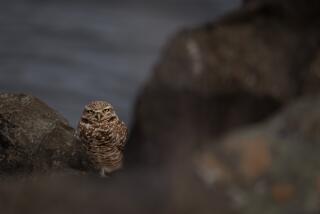BREEDING BIRDS: COMMON BARN OWL
- Share via
COMMON BARN OWL
(Tyto alba )
Description: Pale with dark eyes in a heart-shaped face. Rust-colored above; underparts vary from white to brown.
Habitat: Barns or any dark cavity in rural buildings, cliffs and trees. Occasionally
found in suburban environments.
Diet: Rodents, occasionally amphibians, reptiles and insects.
Call: Makes a raspy, hissing screech.
Displays: Male claps wings together in flight, presents food to female.
Nest: Burrows into crevices, nest occasionally lined with wood chips.
Eggs: White, occasionally nest-stained. Elliptical; just under two inches long.
Natural history note: Populations are declining due to loss of habitat.
Breeding bird atlas: To report bird breeding activity in your neighborhood, or to get information on the breeding bird atlas, call Sea and Sage Audubon Society members Sylvia Gallagher, (714) 962-8990, or Nancy Kenyon, (714) 786-3160.
Note: Map is divided into 5-kilometer squares so that Audubon Society volunteers can more easily survey areas on a regular basis.
Sources: Sea and Sage Audubon Society; “The Birder’s Handbook,” Ehrlich, Dobkin and Wheye, Fireside Books (1988); “Field Guide to the Birds of North America,” National Geographic Society (1987); “Birds of Southern California: Status and Distribution,” Garrett and Dunn, Los Angeles Audubon Society (1981).
Indicates 5-kilometer-square areas where breeding activity has been confirmed.
More to Read
Sign up for Essential California
The most important California stories and recommendations in your inbox every morning.
You may occasionally receive promotional content from the Los Angeles Times.









